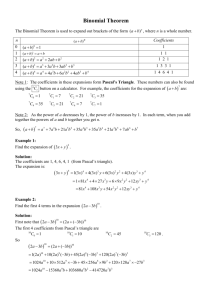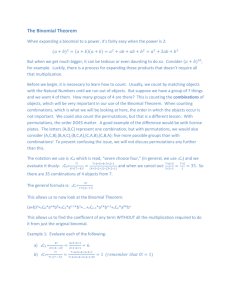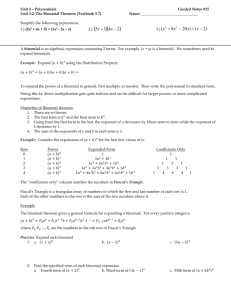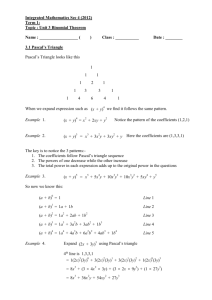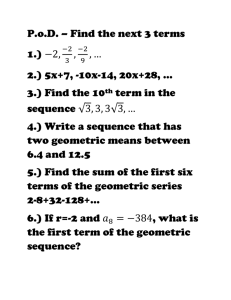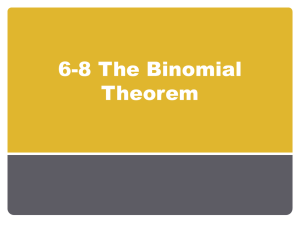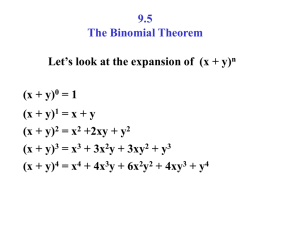Chapter 5. Pascal's Triangle
advertisement
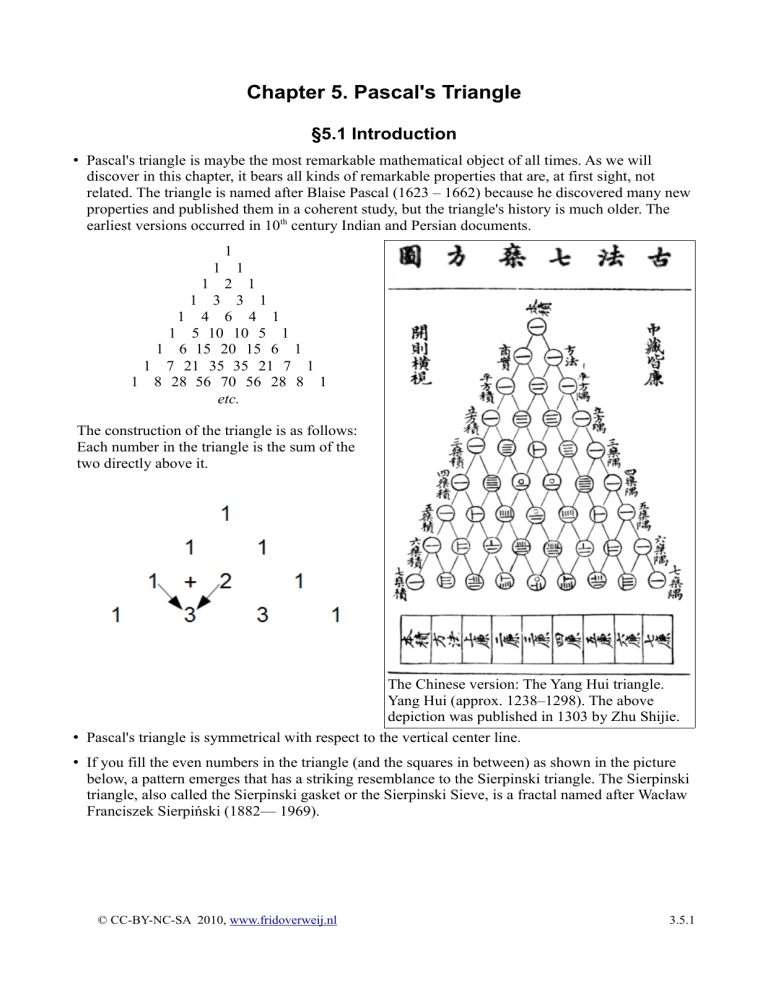
Chapter 5. Pascal's Triangle
§5.1 Introduction
• Pascal's triangle is maybe the most remarkable mathematical object of all times. As we will
discover in this chapter, it bears all kinds of remarkable properties that are, at first sight, not
related. The triangle is named after Blaise Pascal (1623 – 1662) because he discovered many new
properties and published them in a coherent study, but the triangle's history is much older. The
earliest versions occurred in 10th century Indian and Persian documents.
1
1 1
1 2 1
1 3 3 1
1 4 6 4 1
1 5 10 10 5 1
1 6 15 20 15 6 1
1 7 21 35 35 21 7 1
1 8 28 56 70 56 28 8 1
etc.
The construction of the triangle is as follows:
Each number in the triangle is the sum of the
two directly above it.
The Chinese version: The Yang Hui triangle.
Yang Hui (approx. 1238–1298). The above
depiction was published in 1303 by Zhu Shijie.
• Pascal's triangle is symmetrical with respect to the vertical center line.
• If you fill the even numbers in the triangle (and the squares in between) as shown in the picture
below, a pattern emerges that has a striking resemblance to the Sierpinski triangle. The Sierpinski
triangle, also called the Sierpinski gasket or the Sierpinski Sieve, is a fractal named after Wacław
Franciszek Sierpiński (1882— 1969).
© CC-BY-NC-SA 2010, www.fridoverweij.nl
3.5.1
Sierpinski's Sieve
Below 5 iterations of the construction of the Sierpinski fractal. The recurrence definition:
1. Draw a figure (in this case an equilateral triangle pointing to above).
2. Scale the former figure with factor 1/2, make three copies, and stack up the three shrunken
figures triangular fitting in the former figure.
If we start with a square, we come pretty close to the pattern in the Pascal triangle.
Note that the recursive definition has no end. The actual fractal is what would be obtained after
an infinite number of iterations.
↓
© CC-BY-NC-SA 2010, www.fridoverweij.nl
3.5.2
§5.2 Binomial coefficients
• In this paragraph we will take already a quick look at the subject of next chapter “Combinatorial
Analysis.”
• Suppose we have three marbles, a red (R) one, a blue (B) one and a green (G) one. In how many
different ways can we place the marbles in a row?
For the first one I have 3 possibilities, R,B or G. For each of the three first possibilities we have
two possibilities for the second , so 3 times 2 is 6 possibilities for the first two positions. For the
last position we have for six possible rows one marble left. In total 3×2×1 = 6 possible different
rows. We have seen this expression before: The factorial. n different objects can be ordered or
arranged in n! different ways.
• Suppose we have five marbles with different colors and want to pick out three to put them in a
row. In how many different ways can we do this? How many orders can we make?
For the first we have 5 possibilities, for each of them we have left 4 for the second position and
for the third position we have for every 5×4=20 possibilities 3 marbles left. So 5×4×3 = 60
combinations we can make.
5⋅4⋅3⋅2⋅1
5!
5⋅4⋅3=
=
=60
2⋅1
5−3!
• Suppose in the above example we have the colors R, B, G, P, O. We found every possible order.
So we found for instance RGB, RBG, GBR, GRB, BRG, BGR, PRG,... The first 6 (=3!) in this
row consists of the same marbles. Suppose that in the last example we are nor interested in the
order but we want to know how many combinations we can make. The combination RBG is
equal to BGR or GRB. Because there are 3 positions we have found 3! orders for every
combination of 3. So we have to divide this result by 3!
5!
5−3!
5!
=
=10
3!
3!5−3!
RBG
RBP
RBO
RGP
RGO
RPO
BGP
BGO
BPO
GPO
With n=5 different objects we can make 10 combinations on k=3 positions.
The next chapter more about this.
• For this formula, to calculate the number of combinations, we have a special name and
denotation:
The binomial coefficient:
{
nk =0 if k 0
n!
if 0k n
nk= nk = k !n−k
!
nk =0 if k n
}
© CC-BY-NC-SA 2010, www.fridoverweij.nl
Verbally:
nk “n over k” or “n choose k”
It goes without saying that here n and k represent
integers (although it can be defined for two real or
complex valued arguments using the gamma
function).
3.5.3
• Suppose we have n=4 objects, ABCD, on k=2 positions. The number of combinations is 6:
4 = 4! = 4⋅3⋅2! = 4⋅3 =6
2!
2 2!2! 2!2!
ABCD
We can also picture this as: ABCD With k=2 equal objects (O) we can make 6
AB
OOXX combinations on n=4 positions where the other
AC
OXOX n-k=2 positions are left (X).
AD
OXXO
BC
XOOX Or: How many different ways can we choose
BD
XOXO k=2 different objects from n=4 different
CD
XXOO objects.
• This shows us:
n!
n!
n = n
n =
=
= n
Proof:
n−k n−k !n− n−k ! n−k !k ! k
k
n−k
We can also understand this from the above example: Every combination of 3 marbles from 5
marbles automatically leaves a combination of 5-3=2 marbles.
• Remember: x!=x x−1! :
n!n−k 1
n!
n!
n! k
n n =
=
=
k
k −1 k!n−k ! k −1!n−k 1! k ! n−k 1! k!n−k 1!
n!n1
n1!
n1!
n n!−k n!n!n!k
=
=
=
=
= n1
k !n−k 1!
k !n−k 1! k ! n−k 1! k! n1−k !
k
2
n n−1n−2! n n−1 n −n 1
n!
n =
=
=
=
= n n−1
2 2!n−2!
2 n−2!
2
2
2
•
n−1!
n−1!
n!
n
n
n
=
=
= n−1
nk= k!n−k
! k k −1!n−1−k 1! k k −1!n−1−k −1! k k −1
n n−1 n−2 n n−1 n−2 n−k −1 n−k
n−i
=
=
...
=∏
nk= nk n−1
k −i
k −1 k k −1 k−2 k k −1 k −2 k −k −1
k −k
k−1
i=0
1
This corresponds with canceling factors as we have seen:
52 = 52! = 52⋅51⋅50 =22100
52 = 52⋅51⋅50
3!49!
3⋅2⋅1
3 2 1
3
3
•
00=n0=nn=1.
In the next paragraph more about this.
nk= n−kn
nkk −1n =n1
k
1
= nn−1
00=n0= nn=1 n2=n−2n = n −n
2
2
n−i
=∏
for any 0≤k ≤n
n1= n−1n =n nk= nk n−1
k−i
k −1
2
k−1
i=0
• The binomial coefficient has a remarkable relation to the Pascal triangle as we will discover in the
next paragraph.
© CC-BY-NC-SA 2010, www.fridoverweij.nl
3.5.4
§5.3 Binomial theorem
• The Binomial theorem is (in a generalized form) also called the Newton's (generalized) binomial
theorem (Sir Isaac Newton 1643 – 1727).
•
For any n∈ℕ and x , y , z ∈ℝ :
xn
monomial theorem
n
x y
binomial theorem
n
x y z trinomial theorem
Binomial theorem:
x y 2 = x 22xy y 2
x y 3 = x y x 2 2xy y 2
= x 32x 2 yxy 2 yx 22xy 2 y 3
= x 33x 2 y3xy 2 y 3
x y n = a 0 x n y 0 a 1 x n−1 y 1a 2 x n −2 y 2...a n−1 x 1 y n−1a n x 0 y n
The “coefficients” a k in the polynomials are the same as the entries of the nth row (starting with
row 0) of Pascal's triangle!
For instance: n=5, the fifth row in Pascal's triangle 1,5,10,10,5,1. So:
x y 5= x 55 x 4 y 10 x 3 y 210 x 2 y 35 xy 4 y5
•
x y 3 = x y xx xy yx yy
= xxxxxyxyx xyy yxx yxy yyx yyy
= xxxxxyxyx yxxxyy yxy yyx yyy
We now recognize combinations of x-s and y-s. The first and last is “pick k=3 different ones out
of n=3” The middle are “pick k=2 different ones out of n=3” or “pick k=1 different ones out of
n=3.” So:
3 = 3 =1
3 = 3 =3
For the first and last:
and for the others:
So:
0
3
1
2
x y 3= 3 x 3 3 x 2 y 3 y 2 x 3 y 3
0
1
2
3
So the “coefficients” a k in the Binomial theorem are binomial coefficients.
•
n
n 0
n−1 1
n−2 2
1 n−1
0 n
x y = n x y n x y n x y ... n x y n x y
0
1
2
n−1
n
Or:
Newton's generalized binomial theorem.
n
n
x y =∑ n x n −k y k
k =0 k
Here we consider 00 =1. If 00 is considered to be undefined we must add to the above: x , y≠0.
• Since the binomial coefficients correspond with the numbers from Pascal's triangle, we can write:
© CC-BY-NC-SA 2010, www.fridoverweij.nl
3.5.5
00
10
20
03
n=0
11
21
31
n=1
22
32
n=2
33
n=3
etc.
The proof that the binomial coefficients correspond with the numbers from Pascal's triangle, is
already given. In the former paragraph we derived:
nkk −1n =n1
k
This is exactly the definition for a number in the Pascal triangle. In
the beginning of this chapter we have seen that any number in
Pascal's triangle equals the sum of the two numbers directly above.
We also recognize the triangle's symmetry expressed with:
nk=n−kn
• The coefficients of the polynomial expansion of x y n do not have to be the binomial
coefficients of x y n !
3
3 23−k (k=0,1,2,3).
For example: 2 y , the coefficients are:
The binomial coefficients are
k
3 (k=0,1,2,3).
k
• For the monomial theorem we can write:
n
n
x n =1 x−1n=∑ n 1n−k x−1k =∑ n x−1k . Or:
k =0 k
k=0 k
n
n−1
n−1
x = x x = x−11 x = x−1 x n−1x n−1= x−1 x n−1 x x n−2=...=
x−1 x n−1 x−1 x n−2 ... x−1 x1 x 1=
x−1 x n−1 x−1 x n−2 ... x−1 x1 x −11
85=7⋅847⋅837⋅8 27⋅871
n
n−1
So: x n =∑ n x−1k =1∑ x −1 x i
k =0 k
i =0
↓
© CC-BY-NC-SA 2010, www.fridoverweij.nl
3.5.6
§5.4 Some more properties
• The sum of the binomial coefficients in a row n, equals 2 n .
The sum doubles every next row.
1
=20 =1
1
This can be explained by:
1 + 1
=2 =2
2
1 + 2 + 1
=2 =4
n
3
1 + 3 + 3 + 1 =2 =8
∑ nk =11n=2n
k =0
etc.
• Also the Fibonacci sequence shows up in Pascal's triangle.
The sum of the numbers on a diagonal as
shown in the picture is a Fibonacci number.
With this we can derive an other formula for
F n then Binet's formula.
n
F n=∑ n−i
i
i=0
F 8= 8 7 6 5 4 00...=1715101=34
0
1
2
3
4
This is still a lot of calculating. It is questionable if this formula is quicker than applying n
iterations following the recurrence definition. The Golden section is not involved in this formula,
rounding off errors are not an issue now.
• This also shows that a Fibonacci number represents an combinatorial case: Suppose a client at a
cash machine (ATM) requested an €80.- withdrawal. The only notes, under €80.-, available are
€10 and €20 bills. How many ways can this machine give out the €80.- to the client? The answer:
F 8.
First we reduce the problem a little by replacing 80, 10 and 20 by 8, 1 and 2.
n=8 :
11111111 8 = 8 =1
8
0
2111111
1211111
⋮
67=71=7
221111
⋮
22211
⋮
52=53=10
2222
04=41=1
6 = 6 =15
4
2
© CC-BY-NC-SA 2010, www.fridoverweij.nl
The number of possibilities is the sum:
1715101=34=F 8
3.5.7
§5.5 Examples
n
1. We have seen:
∑
k =0
n
∑
Work
k =0
n−1
n−1
n
n x−1k =1 x−1 x i= x n . so 2 n=1 2i =
n .
∑
∑
∑
k
i =0
i =0
k=0 k
n−1
nk to 1∑ 2
i
using the rules applicable to binomial coefficients.
i=0
= n . So:
kt k −1t = t1k . With t+1=n: n−1k n−1
k −1
k
n−1 =∑ n−1 n−2 n−2 =∑ n−1 n−2
∑ nk = ∑ n−1
k −1 k k −1 k −2 k k −1
k
n−3 n−3 = etc.
k −2 k −3
n−2 ... n−n
n−n
∑ nk = ∑ n−1
k
k −1
k −n−1
k −n
n−n−1 =00 because n−n−10 so k −n−10
k −n−1
[ n−n−1
]
k −n
Rule:
n
n
n
n
k =0
k=0
k=0
k =0
n
n
k =0
k=0
∑ n−2 ...∑ 0 ∑ 0 =2
∑ nk = ∑ n−1
k
k
k
k
If in n k 0 or k n then n =0 . So for example the second term
k
k
n−2 n−2 ... n−2 00...
above sum counts: 0
So:
0
1
n−2
n
n−1
n −2
0
0
k =0
k=0
k =0
k=0
k =0
n−1
n−2
k −1
in the
n−1
2 n−2...11=1∑ 2i
i =0
n−1
i
n
2. Proof that 1∑ 2 =2 using the theorem of geometric sequences.
i=0
2
n
is 1 plus a geometrical sequence
m
n−1
i=0
i =0
∑ ar i=∑ 2i . For geometrical sequences we used
the recipe:
First term minus last term multiplied by r=2: 1−2⋅2n −1
1− 2⋅2n−1 n−11
=2
−1=2n−1
Divide the result by 1-r:
1−2
n−1
i
n
n
So: 1∑ 2 =12 −1=2 □.
i=0
n
3. Proof:
∑ −1k
k =0
n
nk=0
n
∑ −1k nk =∑ nk 1n −k −1k =1−1n=0 □.
k =0
k=0
4. When discussing arithmetic sequences we have seen that
1
n1 .
1
n 2n
1234...n= n n1=
holds. Proof: 2 n n1=
2
2
2
© CC-BY-NC-SA 2010, www.fridoverweij.nl
3.5.8
n1 n n−1!
n1!
1
n n1=
=
= n1
2
2 n−1!
2! n1−2!
2
□.
5. Proof the equation in example 3 in a different way, given the fact that Pascal's triangle bears
the sequence 1,2,3,4,...in two of its diagonals.
n−1
n
1234...n=∑ 1i =∑ i = 1 2 ... n
1
1
1
1
i =0
i=1 1
1 = 2 =1 and n1 = n n
With:
we can write:
1
2
k
k −1
k
1 2 3 ... n = 2 2 3 ... n =
1
1
1
1
2
1
1
1
2 + 3 +...+ n−1 +
n
= 2 +
2
1
1
2
1
3
n
=
+ 3 +...+ n−1 +
2
1
2
1
4 +
n
=
+...+ n−1 +
2
2
1
=
⋮
n1
=
2
□
1
n 2n n1
=
=sn where s n is a triangular number
So: 1234...n= n n1=
2
2
2
( see former paragraph)
6. As said before: combinatorial analysis is the subject of next paragraph. But here an question
up front: The “handshake problem.”
Suppose a room full of n people. Each person in the room shakes hands once with each other
person. How many handshakes will there be?
This is precisely expressed with the binomial coefficient with n=n and k=2: “How many
combinations of k=2 can be made with n different objects. How many ways can we choose
k=2 different object from n different objects.”
2
n .
n = n −n
So:
Remember:
(see rules).
2
2
2
n2 n
So, 123...n= n1 =
(see example 4) represents the “handshake problem”
2
2
for a room full of n+1 people.
n
∑ ∑
∑
7. proof:
∑
t =1
n
t =1
t1 − t = n1
2
2
2
n
n
n 2n n2−n
t 1 − t =
−
= n=123...n= n1
2
2
2
2
2
t =1
t=1
□.
We can also use what we found in example 10 of chapter 2 “Recursion:”
© CC-BY-NC-SA 2010, www.fridoverweij.nl
3.5.9
k
∑ P i1−P i =P k1−P 1
i=1
n
∑
t =1
t 1 − t = n1 − 1 = n1 −0= n1
2
2
2
2
2
2
8. Proof:
□.
nk= n−kn n−1k
nk=n−kn and nk= nk kn−1
−1
n−1 = n n−1
nk=n−kn = n−kn n−kn−1−1= n−kn n−1−k
n−k k □.
Proof: ∑ k n =n ∑ n−1 =n 2
k
k−1
Use the rules
9.
n
n
k =0
k=1
n
n =
k
k=0
k =0 01...
∑k
n
∑k
k=1
n−1
n
n
n
n =∑ k n n−1 =∑ n n−1 =
k k=1 k k −1 k=1 k −1
n ∑ n−1 =
k=1 k −1
nanb...=n ab...
n−1
14
14
10. Solve: =
6
13− x
=n ∑ n−1 =n 2n−1 □.
k
k=0
6=13−x ⇔ x =7∨ x=5
{6=14−13
x}
Or:
14!
14!
=
⇔ 6!8!=13−x !1x !⇔ x=7∨x=5
6!8! 13−x !1 x!
11. What is the sixth term in the polynomial expansion of x−2y7 ?
7
7
x−2y =∑ 7 x 7−k −2yk =∑ ±2k 7 x 7− k y k
±: + if k = even, - if k is odd.
k
k =0 k
k =0
There are 8 (k=0...7) terms in total. The sixth term is when k=5.
7! 2 5
−25 7 x 7−5 y 5=−25
x y =−32⋅21x2 y 5=−672x 2 y 5 .
5!2!
5
7
12. The coefficient of x 3 y 4 in the polynomial expansion of x−2y7 is?
7!
4 7
=16
=16⋅35=560.
k=4: 2
4!3!
4
1 10
13. What is the constant term in the polynomial expansion of x − 2 ?
x
3
© CC-BY-NC-SA 2010, www.fridoverweij.nl
3.5.10
10
10
k
10
10
1
1
1
x − 2 =∑ 10 x 310−k − 2 =∑ 10 x30−3k ± 2k =∑ ± 10 x 30−3k−2k =
k
x
x
x
k =0 k
k =0 k
k=0
3
10
=∑ ± 10 x30−5k ±: + if k = even, - if k is odd.
k
k=0
A constant term is a term without variables: x 0=1 so 30−5k =0⇔ k =6.
10! 6!⋅7⋅23⋅32⋅5⋅2
10 =
=
=7⋅2⋅3⋅5=210
6
6!4!
6!2 2⋅3⋅2
3
14. What is the coefficient of x 5 in the polynomial expansion of x −
1 10
?
x2
30−5k=5⇔ k =5.
3 2
10!
5!⋅2⋅3⋅7⋅2 ⋅3 ⋅5⋅2
− 10 =−
=−
=−7⋅2 2⋅32=−252
2
5
5!5!
5!5⋅2 ⋅3⋅2
x 3−
1 10 30 10 25
=x −
x ...−252x5210− 10 x−5... x−20
2
1
7
x
15. The coefficient of x
75−4k
in the polynomial expansion of
1
2x
2x
3
25
is two times the
coefficient of x 79−4k . Find k.
25
25
25
1 25
3 25−k 75−4k
=∑ 25 3x3 25−k 2x −k =∑ 25 3 25− k x 75−3k 2−k x−k =∑ 25
x
.
2x
k
2k
k =0
k=0 k
k=0 k
79−4k=75−4k4=75−4k −1 so:
25−k
25− k1
25!3 25− k
2⋅25!3 26− k
25 3
25 3
=2
⇔
=
⇔
k
k −1 2 k−1
2k
k !25−k !2k k −1!26−k !2k−1
26−k 25!325−k 2k⋅25!326−k 2
26−k
26−k
⇔
=
⇔26−k 3
=12k⋅3
k
k
k !26−k ! 2
k !26−k !2
k
( p! and 2 never 0, so denominator never 0)⇔ 26−k =12k ⇔ k =2.
The third (k=2) term's coefficient is 2 times the second (2-1=1) term's coefficient.
2x 3
16. The middle term in the polynomial expansion of 1−
14
k
14
x 2 14
is?
2
x 2 14
x2
x 2k
1− =∑ 14 −
=∑ ± 14 k The middle term of in total 15 terms is term 7:
2
2
k 2
k =0 k
k=0
14
3
2
x
14! 14
2 ⋅3 ⋅2⋅5⋅11⋅2 2⋅3⋅13⋅2⋅7 14
3⋅11⋅13 21
429 21
− 14 7 =−
x
=−
x =−
x =−
x
7
2
7
4
7 2
16
7!7!2
7⋅2⋅3⋅5⋅2 ⋅3⋅2⋅2
2
17. Three successive coefficients in the polynomial expansion of 1x n are:
12650, 53130 and 177100. Find n.
n
1x =∑ n x k. The coefficient of the nth term is
k=0 k
n!
n =
=12650 ⇔ n!=k ! n−k !⋅12650.
k k!n−k !
n
nk.
© CC-BY-NC-SA 2010, www.fridoverweij.nl
3.5.11
n!
n =
=53130⇔ n!= k 1!n−k −1!⋅53130.
k 1 k 1! n−k −1!
n!
n =
=177100 ⇔ n!= k 2!n−k −2!⋅177100.
k 2 k 2!n−k −2!
(x! never 0, so denominator never 0.)
k!n−k !⋅12650=k 1! n−k −1!⋅53130⇔
k!n−k n−k −1!⋅12650=k ! k 1 n−k −1!⋅53130⇔
n−k ⋅12650=k 1⋅53130 ( x! never 0)⇔
12650n=65780k 53130
k 1!n−k −1!⋅53130=k 2!n−k −2!⋅177100 ⇔
k 1!n−k −1 n−k −2!⋅53130=k 2 k 1!n−k −2!⋅177100 ⇔
n−k −1⋅53130= k 2⋅177100 ⇔53130n=230230k 407330
53130n=230230k407330
53130n=230230k407330
12650n=65780k53130 ⋅3.5= 44275n=230230k 185955
8855n=
221375
⇔ n=25
From this we can derive that k=4. So it concerns the fifth, sixth and seventh term.
© CC-BY-NC-SA 2010, www.fridoverweij.nl
3.5.12

